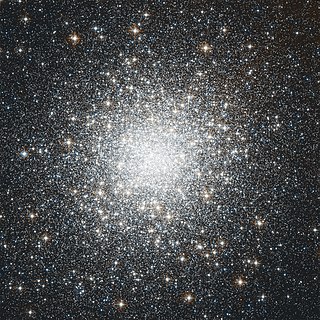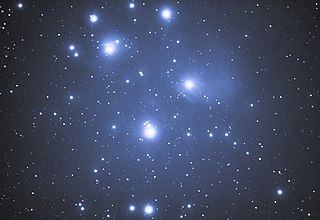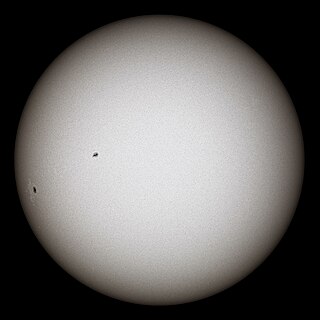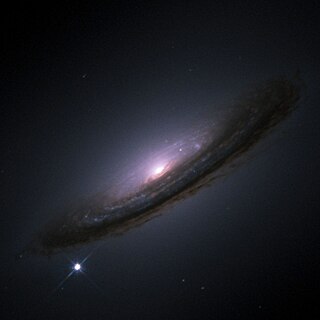Related Research Articles

A globular cluster is a spheroidal conglomeration of stars that is bound together by gravity, with a higher concentration of stars towards its center. It can contain anywhere from tens of thousands to many millions of member stars, all orbiting in a stable, compact formation. Globular clusters are similar in form to dwarf spheroidal galaxies, and the distinction between the two is not always clear. Their name is derived from Latin globulus. Globular clusters are occasionally known simply as "globulars".

An open cluster is a type of star cluster made of tens to a few thousand stars that were formed from the same giant molecular cloud and have roughly the same age. More than 1,100 open clusters have been discovered within the Milky Way galaxy, and many more are thought to exist. Each one is loosely bound by mutual gravitational attraction and becomes disrupted by close encounters with other clusters and clouds of gas as they orbit the Galactic Center. This can result in a loss of cluster members through internal close encounters and a dispersion into the main body of the galaxy. Open clusters generally survive for a few hundred million years, with the most massive ones surviving for a few billion years. In contrast, the more massive globular clusters of stars exert a stronger gravitational attraction on their members, and can survive for longer. Open clusters have been found only in spiral and irregular galaxies, in which active star formation is occurring.

A star is a luminous spheroid of plasma held together by self-gravity. The nearest star to Earth is the Sun. Many other stars are visible to the naked eye at night; their immense distances from Earth make them appear as fixed points of light. The most prominent stars have been categorised into constellations and asterisms, and many of the brightest stars have proper names. Astronomers have assembled star catalogues that identify the known stars and provide standardized stellar designations. The observable universe contains an estimated 1022 to 1024 stars. Only about 4,000 of these stars are visible to the naked eye—all within the Milky Way galaxy.

A supernova is a powerful and luminous explosion of a star. A supernova occurs during the last evolutionary stages of a massive star, or when a white dwarf is triggered into runaway nuclear fusion. The original object, called the progenitor, either collapses to a neutron star or black hole, or is completely destroyed to form a diffuse nebula. The peak optical luminosity of a supernova can be comparable to that of an entire galaxy before fading over several weeks or months.

Star clusters are large groups of stars held together by self-gravitation. Two main types of star clusters can be distinguished. Globular clusters are tight groups of ten thousand to millions of old stars which are gravitationally bound. Open clusters are more loosely clustered groups of stars, generally containing fewer than a few hundred members, that are often very young. As they move through the galaxy, over time, open clusters become disrupted by the gravitational influence of giant molecular clouds. Even though they are no longer gravitationally bound, they will continue to move in broadly the same direction through space and are then known as stellar associations, sometimes referred to as moving groups.

Wolf–Rayet stars, often abbreviated as WR stars, are a rare heterogeneous set of stars with unusual spectra showing prominent broad emission lines of ionised helium and highly ionised nitrogen or carbon. The spectra indicate very high surface enhancement of heavy elements, depletion of hydrogen, and strong stellar winds. The surface temperatures of known Wolf–Rayet stars range from 20,000 K to around 210,000 K, hotter than almost all other kinds of stars. They were previously called W-type stars referring to their spectral classification.

A stellar black hole is a black hole formed by the gravitational collapse of a star. They have masses ranging from about 5 to several tens of solar masses. They are the remnants of supernova explosions, which may be observed as a type of gamma ray burst. These black holes are also referred to as collapsars.

Michel Gustave Édouard Mayor is a Swiss astrophysicist and professor emeritus at the University of Geneva's Department of Astronomy. He formally retired in 2007, but remains active as a researcher at the Observatory of Geneva. He is co-laureate of the 2019 Nobel Prize in Physics along with Jim Peebles and Didier Queloz, and the winner of the 2010 Viktor Ambartsumian International Prize and the 2015 Kyoto Prize.

The following outline is provided as an overview of and topical guide to astronomy:

A Type Ia supernova is a type of supernova that occurs in binary systems in which one of the stars is a white dwarf. The other star can be anything from a giant star to an even smaller white dwarf.

Nuclear astrophysics is an interdisciplinary part of both nuclear physics and astrophysics, involving close collaboration among researchers in various subfields of each of these fields. This includes, notably, nuclear reactions and their rates as they occur in cosmic environments, and modeling of astrophysical objects where these nuclear reactions may occur, but also considerations of cosmic evolution of isotopic and elemental composition (often called chemical evolution). Constraints from observations involve multiple messengers, all across the electromagnetic spectrum (nuclear gamma-rays, X-rays, optical, and radio/sub-mm astronomy), as well as isotopic measurements of solar-system materials such as meteorites and their stardust inclusions, cosmic rays, material deposits on Earth and Moon). Nuclear physics experiments address stability (i.e., lifetimes and masses) for atomic nuclei well beyond the regime of stable nuclides into the realm of radioactive/unstable nuclei, almost to the limits of bound nuclei (the drip lines), and under high density (up to neutron star matter) and high temperature (plasma temperatures up to 109 K). Theories and simulations are essential parts herein, as cosmic nuclear reaction environments cannot be realized, but at best partially approximated by experiments. In general terms, nuclear astrophysics aims to understand the origin of the chemical elements and isotopes, and the role of nuclear energy generation, in cosmic sources such as stars, supernovae, novae, and violent binary-star interactions.

A Type II supernova or SNII results from the rapid collapse and violent explosion of a massive star. A star must have at least eight times, but no more than 40 to 50 times, the mass of the Sun (M☉) to undergo this type of explosion. Type II supernovae are distinguished from other types of supernovae by the presence of hydrogen in their spectra. They are usually observed in the spiral arms of galaxies and in H II regions, but not in elliptical galaxies; those are generally composed of older, low-mass stars, with few of the young, very massive stars necessary to cause a supernova.

A quasi-star is a hypothetical type of extremely massive and luminous star that may have existed early in the history of the Universe. They are thought to have lived around 7-10 million years due to their immense mass. Unlike modern stars, which are powered by nuclear fusion in their cores, a quasi-star's energy would come from material falling into a black hole at its core. They were first proposed in the 1960s and have since provided valuable insights into the early universe, galaxy formation, and the behavior of black holes. Although they have not been observed, they are considered to be a possible progenitor of supermassive black holes.

In astronomy, a common envelope (CE) is gas that contains a binary star system. The gas does not rotate at the same rate as the embedded binary system. A system with such a configuration is said to be in a common envelope phase or undergoing common envelope evolution.

Vassiliki Kalogera is a Greek astrophysicist. She is a professor at Northwestern University and the director of the Center for Interdisciplinary Exploration and Research in Astrophysics (CIERA). She is a leading member of the LIGO Collaboration that observed gravitational waves in 2015.
V1309 Scorpii is a contact binary that merged into a single star in 2008 in a process known as a luminous red nova. It was the first star to provide conclusive evidence that contact binary systems end their evolution in a stellar merger. Its similarities to V838 Monocerotis and V4332 Sagittarii allowed scientists to identify these stars as merged contact binaries as well.
Douglas Cameron Heggie is a Scottish applied mathematician and astronomer, formerly holding the Personal Chair of Mathematical Astronomy at the School of Mathematics at the University of Edinburgh. His main research interests are in stellar dynamics.
LB-1 is a binary star system in the constellation Gemini. In 2019 a paper in Nature proposed the system contained an unusually massive stellar black hole outside of ordinary single stellar evolution parameters. However, analyses in 2020 found the original 2019 conclusion to be incorrect. Some researchers now believe the system consists of a stripped B-type star and a massive rapidly rotating Be star.
Ken'ichi Nomoto is a Japanese astrophysicist and astronomer, known for his research on stellar evolution, supernovae, and the origin of heavy elements.
References
- 1 2 3 4 "Dr JJ Eldridge - The University of Auckland". www.physics.auckland.ac.nz. Retrieved 16 January 2019.
- 1 2 Meg (4 December 2017). "Reintroducing JJ Eldridge". astrotweeps. Retrieved 16 January 2019.
- ↑ Eldridge, John J. (2 February 2005). Progenitors of Core-Collapse Supernovae (Thesis). Cornell University. arXiv: astro-ph/0502046 . Bibcode:2005PhDT.........7E.
- ↑ Morton, Jamie (5 January 2018). "Science Made Simple: JJ Eldridge on binary stars". The New Zealand Herald. ISSN 1170-0777 . Retrieved 16 January 2019.
- 1 2 "Globular clusters 4 billion years younger than previously thought". ScienceDaily. Retrieved 16 January 2019.
- 1 2 Morton, Jamie (5 June 2018). "Stellar discovery could prompt a rethink on the universe". The New Zealand Herald. ISSN 1170-0777 . Retrieved 16 January 2019.
- ↑ "Structure And Evolution Of Stars, The". blackwells.co.uk. Retrieved 17 January 2019.
- ↑ Kirkpatrick, Jessica (3 October 2016). "Women In Astronomy: Guest Post: Understanding Gender Fluidity". Women In Astronomy. Retrieved 17 January 2019.
- 1 2 "JJ Eldridge". Curious Minds, He Hihiri i te Mahara. 26 May 2017. Retrieved 16 January 2019.
- 1 2 "Pleiades Award - The University of Auckland". www.physics.auckland.ac.nz. Retrieved 17 January 2019.
- ↑ "Steering Committee". 25 May 2016. Retrieved 16 January 2019.
- ↑ "Celebrate Equality! Voting is Underway for the New Zealand LGBTI Awards Finalists". MediaPA. 2 August 2018. Archived from the original on 17 April 2019. Retrieved 16 January 2019.
- ↑ "HERO". NEW ZEALAND LGBTI AWARDS. Archived from the original on 16 August 2019. Retrieved 16 January 2019.
- ↑ Ashimbayeva, Elina. "On astrophysics and figuring out who you are by JJ Eldridge". www.kiaora.co. Retrieved 26 August 2019.